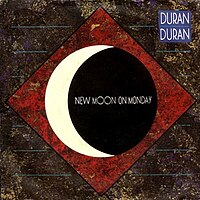Piano Sheets > Duran Duran Sheet Music > New Moon On Monday (ver. 1) Piano Sheet
New Moon On Monday (ver. 1) by Duran Duran - Piano Sheets and Free Sheet Music

About the Song
"New Moon on Monday" is the tenth single by Duran Duran, released in January 1984.
The second single to be lifted from the band's 1983 album Seven and the Ragged Tiger, the song was another success, reaching the Top 10 on both the British and American music charts. On February 11, 1984, the single reached #9 on the UK Singles Chart and on March 17, it reached #10 on the U.S. Billboard Hot 100.
Inexplicably, it did not chart well in Australia and Scandinavia; territories where its predecessor, "Union of the Snake", had been a big hit. This trend was reversed with the next single, "The Reflex", which became a worldwide number one. Duran Duran are an English rock band from Birmingham, United Kingdom. They were one of the most commercially successful of the 1980s bands and a leading band in the MTV-driven "Second British Invasion" of the United States. Since the 1980s they have placed 14 in the Top.
Download this sheet!
About the Artist

Random article
Music sheets - what is all about? Back in the 19th century, songs in the United States were popularized by musicians through music sheets. It was only in the 1950s when musicians started to bring music sheets to bands so they could play, allowing more people to hear their compositions.
Simply, a music sheet is musical composition in printed form. It is composed of unbound sheets of paper where a musical notation of a song is printed. Many associate it with popular music. However, musicians say popular songs are not the only ones written down on paper. Many classical songs were published in music sheets and classical musicians performed even unfamiliar songs with these printed compositions.
(More...)
